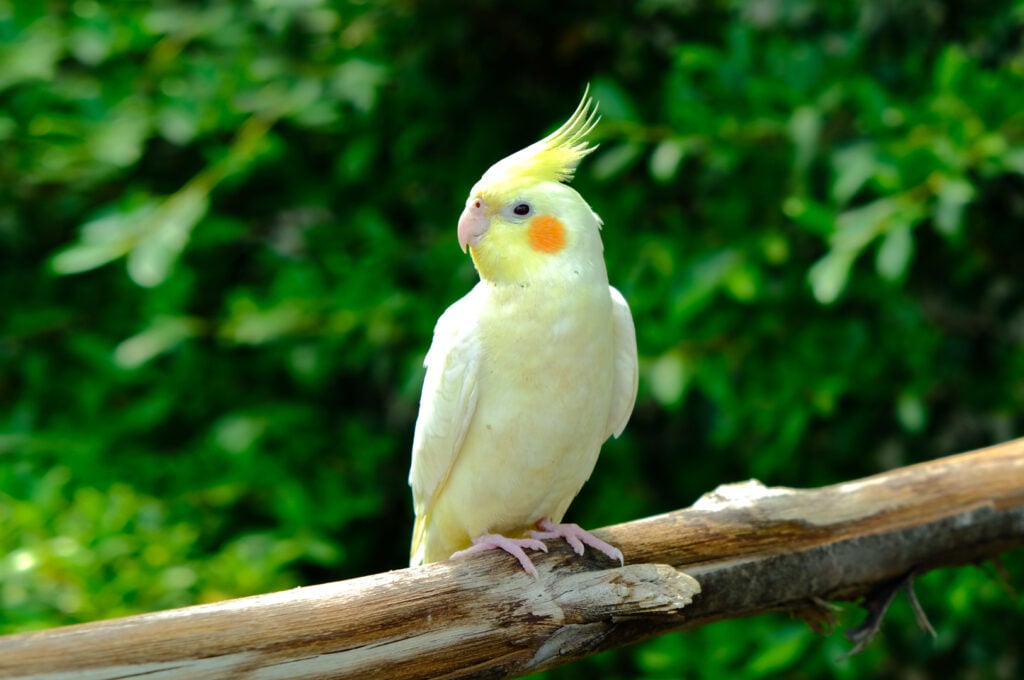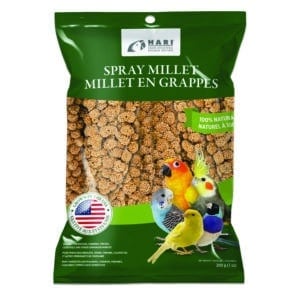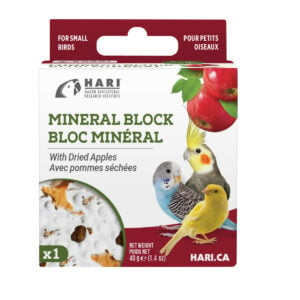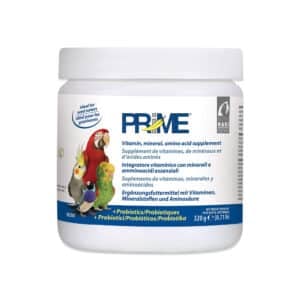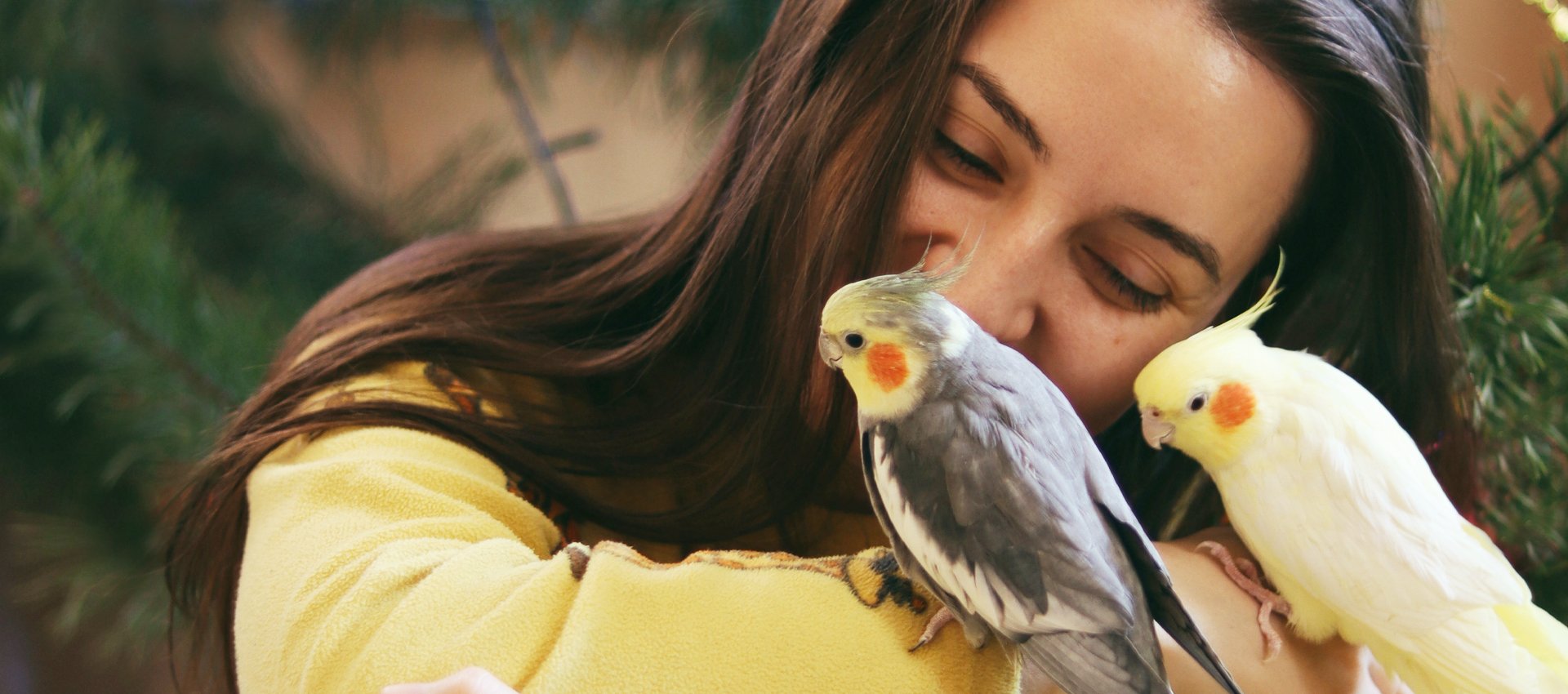Your cart is currently empty!
HARI Official Brand Site
Common Species
Nymphicus hollandicus
Origin/Habitat
Australia
Gentle, Whistle-Ready, Loving Companions
Intelligent, inquisitive, and affectionate are just a few of the reasons why Cockatiels have become one of the most popular companion birds. Their gentle and friendly nature allows them to fit in easily with most lifestyles – whether it be a busy household or a single individual. Cockatiels enjoy vocalizing and whistling, but are not as loud as some other parrots, and they are good at mimicry too. Cockatiels are clever birds, capable of learning a variety of tricks and enjoy new challenges. Loving and cuddling, Cockatiels adore being petted and touched and thrive on human attention and never pass up the opportunity to show their affection.
Cockatiels are originally from Australia and flocks are usually found near grasslands and open fields with a source of water nearby.
Nymphicus hollandicus is the sole species within the Nymphicus genus. Although the wild cockatiel is mostly gray, many many colour variations have emerged since the late 1940s. These man-made mutations, resulting from multiple generations of domestic breeding, include Lutino (yellow), Cinnamon (light brown), Pearl, Pied, and White Face. Today, these color variations are widely available.
Cockatiels can live for 15-25 years-and sometimes even longer depending on care.
Health Booklet
Keeping track of bird health by recording their growth, development, behavior and environment in a booklet can help ensure that your companion parrot will be healthy and happy for many years to come.
Physical Description
Cockatiels are usually 30 to 35 cm long (12 to 14 in) and weigh 90 to 120 g (3 to 4 oz).
The “Normal” cockatiel is known for its gray feathers and orange facial patches. However, since the first pied mutation was recorded in 1949, there have been numerous selectively bred mutations that combine multiple visual colors, such as Lutino Pearl, Pearl Pied, or Fallow Pied.


In some cases, the orange patches lack lipochrome pigmentation, resulting in yellow cheeks and various deviations with the White Face mutation.
Sex
Determining the sex of adult cockatiels is relatively easy regardless of whether they are a “normal” gray or a mutation. Females tend to have a less vibrant orange cheek patch and yellow bars on their tail and primary feathers. Males, on the other hand, have bright orange cheek patches and completely gray tail feathers. Young cockatiels will resemble females until their first molt, which typically occurs at 6 to 8 months. During this time, the male’s facial feathers will usually be the first noticeable change in color. It may take up to a year for the male’s tail feathers to fully change color. In the case of mutations, determining sex is similar, but closer inspection of the “barred” feathers may be required, especially for Lutinos as the yellow barring on white feathers can be difficult to see. Sexing Albino cockatiels visually is even more challenging, so it’s worth keeping in mind that, like many other parrot species, a DNA blood test is a reliable tool for determining a bird’s sex.

Personality Traits & Behaviours
Cockatiels are known for their loving, social, and gentle characteristics. These intelligent birds are playful and active, and they enjoy exploring, foraging, and learning new tricks. With gentle care, these birds will happily interact with the entire family. As social creatures, they need to feel like they are part of a flock and enjoy vocalizing to their peers.

Noise Level/Speech/Song
Compared to larger parrots, cockatiels are relatively quiet birds. Because of their strong flocking nature, cockatiels might call out in search of a family member or perhaps another cockatiel. Males tend to be a bit louder-especially if they’re in search of a female.
Cockatiels are not really known for their ability to mimic human speech, but some do learn phrases. They are especially known for imitating popular whistled tunes if repeated enough.

Intelligence & Learning
Cockatiels can be very inquisitive birds. They can pick up new behaviours and tricks after just a few trials. Because cockatiels are so intelligent, it is important to provide them with stimulating toys and foraging opportunities based on their natural behaviors to keep them busy, entertained, and to get plenty of exercise.

Threats/Conservation
Overall cockatiel populations are on the rise; therefore, this is no major concern for this species.

Relationship with Humans
Cockatiels are known for their strong flocking nature and often consider their human caregivers as members of their flock. They can recognize all family members and enjoy their presence, although they don’t require constant attention. Compared to larger parrot species, cockatiels are usually less destructive, but it’s important to supervise their playtime outside their cage as they forage on the ground. If you have other pets in the house, it’s essential to keep this behavior in mind. While cockatiels can easily adapt to family life, it’s advisable to monitor younger children when interacting with them due to their size. If you’re home frequently and can provide plenty of attention, a single bird can be content. However, if your life becomes too busy, it’s recommended to consider getting a companion of the same species as cockatiels thrive in flock settings.
Care
There is a large selection of cages and starter kits for you to choose from for your pet Cockatiel. The general rule of thumb when buying a bird cage is to buy the largest cage you can afford. For optimum health and safety, the cage should be at least two and a half times the width of the bird’s wingspan in all directions. Cage bar spacing should not exceed 12.3 mm (0.48 in) and their tail feathers should not be able to touch the bars when they are perched comfortably. A rectangular cage with horizontal bars in which your bird has plenty of room to climb and play is the best environment for your cockatiel. Your small bird will be happiest in a well-ventilated room with as much natural light as possible, yet away from direct sunlight and drafts. Ideally, the cage should be about 3 to 4 ft off the floor. Your bird will want to be part of the action but not right in the middle of it. Avoid placing your bird’s cage in the kitchen as there are many hazards including vapors from heated PTFE coated pans (PTFE is better known as TeflonTM), hot stoves, pots of boiling water, and cooking fumes all of which can be very harmful to your bird. The cage and accessories should be thoroughly cleaned and disinfected weekly. Make sure your bird stays healthy by providing them with fresh food and water every day. Don’t forget to wash their dishes daily!
Your cockatiel’s health and happiness depend on daily exercise and socialization. As a flocking bird, you are their flock, and the more time you spend with them, the more they will warm up to you. Always keep a close eye on your feathered friend when they are out of their cage, making sure they do not have access to dangerous areas such as open windows or doors, hot stoves, moving ceiling fans, large panes of glass, or harmful items such as painted or treated wood or toxic house plants. Additionally, avoid exposing your bird to sprays like perfume, air fresheners, aerosol sprays, or hair products by keeping them out of rooms where these products are frequently used. It is highly recommended that you do not leave your cockatiel unattended with other pets, such as dogs, cats, or ferrets. If you are looking for a secure and comfortable home for your pet, Vision Cages offers excellent options with easy-to-clean cages and all the necessary safety features.
The basic diet of a cockatiel consists of a high-quality seed blend. Seed diets are designed to provide the nutrients your cockatiel needs to stay healthy provided they eat every seed in the mix. VME/Gourmet seed is an excellent basic diet because fat-soluble vitamins, including vitamin A, are added to hulled oat groats (a favourite seed). The challenge with a seed diet is that your cockatiel will likely pick out their favourite seeds and ignore the rest of the nutritious ingredients. It is advisable to add a vitamin supplement such as PRIME to achieve optimal nutrition. Seed diets are also very high in fat and can lead to health problems such as obesity. A healthier food choice for your cockatiel is an extruded pellet-based diet like Tropican Lifetime Formula. Most cockatiels will readily accept Tropican in their diet, however, any change in diet should be done gradually. Check out our feeding recommendations for most passerines and small species. If you are feeding your cockatiel a pellet-based diet, ask your vet before adding PRIME, as you may be feeding too many vitamins (the pellets are already fortified with vitamins and minerals). Sprinkle PRIME onto fresh leafy greens treats such as sprouts, spinach, romaine lettuce, parsley, dandelions, clover, and chickweed. Give daily during the molting and breeding season, and the rest of the year, two or three times a week.
Supplements such as cuttlebones, HARI Mineral blocks, Clay-Cal®, and HARI Oyster Shells should be provided for your cockatiel as they are good sources of calcium. Keep charcoal available to help aid in digestion or to help eliminate dietary toxins.
Your cockatiel will also enjoy fresh enrichments foods such as spinach, kale, romaine lettuce, broccoli, carrot, or apple. These should be washed well and offered to your cockatiel a few times a week. Always remove any fresh foods within 3 hours to prevent your pet from eating spoiled food.
Offer a variety of healthy treats for your cockatiel, including millet, honey sticks and egg biscuits. Avoid salty or sugary foods. Never feed your cockatiel chocolate, alcohol, caffeine beverages or avocado, as even small amounts can be toxic.
Of course, fresh water every day is very important too. Your cockatiel’s water bowl should be washed and refilled daily.
Cockatiels typically need 10 to 12 hours of uninterrupted sleep. Many bird owners will cover the bird cage at night to help block out extra light (especially during the summertime). A cover can also keep the cage warmer (for those living in colder climates).
Placing a comfortable perch higher up in the cage will give them a sense of security and keep their feet healthy. If you do not plan on covering the cage or if the bird suffers from night terrors, try using an infrared basking light or a small night light in the room.
Since your cockatiel stands on its feet around the clock, it’s crucial to provide a diverse range of perch sizes and types to keep their feet healthy. There are many different types of wooden perches and ladders available, as well as rope and swinging perches. However, it’s important to ensure that the perches you choose are the appropriate size for your bird’s feet. Additionally, you can add natural branches to the cage to supplement the standard perches. Fresh branches, such as willow, alder, ash, birch, or apple, are perfect for perching and chewing. Just be sure to remove the leaves and replace them every 4-6 weeks.
Cockatiels are extremely energetic and love to play, so it’s important to keep them entertained. Make sure to provide them with lots of toys, such as wood for chewing, rope or leather for preening, a bell, and a swing. It’s recommended to have at least three different types of toys in their cage at all times. To prevent boredom, swap out the toys every week or two with new ones. If you’re unsure which toys are suitable, check out the HARI Smart.Play and HARI Active.Play toys, which are designed for birds of specific sizes and purposes.
Standard cages are designed for a cockatiel that will be allowed out each day for exercise. One of the first things you should do when bringing a new cockatiel home is to spend time with them. This can include talking to them, playing music, and providing them with toys to keep them entertained. It is also important to establish a routine for feeding, cleaning, and interacting with your bird.
When it comes to training, the most important thing is to be patient and consistent. Start with simple commands such as “step up” and “step down” and reward your bird with treats or praise when they follow through. Over time, you can gradually move on to more complex commands and tricks.
Socializing your cockatiel is also crucial for their well-being. This can include introducing them to other people and pets in your household, as well as providing them with opportunities to interact with other birds. Just be sure to supervise these interactions to ensure everyone stays safe.
With proper training and socialization, your pet cockatiel can become a well-behaved and beloved member of your family.
Daily bathing is essential to the health of your bird. Bathing moisturizes nasal passages and feet and keeps your birds’ feathers and skin in excellent shape. Cockatiels will often bathe on their own if you provide them with a bird bath. If your bird is reluctant to bathe on their own, you can use a spray bottle with warm water to gently mist them. Be sure to remove seeds or pellets from the cage before misting as damp food can grow mold and bacteria. Always bathe your bird early in the day and let them dry naturally in a draft-free area.
To keep your pet cockatiel friendly and approachable, it’s best to trim their flight feathers. This process is painless and similar to a regular haircut. By making sure your bird can’t fly too high, but can still glide down safely, you’ll be fostering a safer environment for you and your pet. Since cockatiels molt twice a year, it’s important to trim their flight feathers accordingly. You’ll also need to groom their toenails regularly since they are much softer than those of other parrot species and can easily become overgrown. To ensure that your bird is trimmed safely, it’s highly recommended that you consult a professional bird groomer to trim the wings and nails. It’s easy to accidentally clip a blood feather if you’re not sure what you’re doing. While wing trimming is not a guaranteed way of preventing flight, it can certainly help. Even with trimmed wings, one or two grown-in feathers can give your cockatiel flight ability. Therefore, it’s crucial to never take your cockatiel outside without a secure cage or a properly fitted bird harness.
It is important to provide cockatiels with a safe environment to ensure the longest lifespan. The following is a list of common household dangers: non-stick surfaces such as TeflonTM, oven cleaner and self-cleaning ovens, cigarette smoke, paint and paint fumes, scented candles, household cleaners, floor polish, hairspray, chlorine bleach, perfume, aerosol sprays, nail polish and nail polish remover fumes and ingesting harmful or toxic house plants. It’s important to make sure everyone in the household is aware of food and other products that are potentially toxic to cockatiels, such as avocados, chocolate, coffee beans, onions, salt, and fruit seeds or pits. Additionally, ceiling fans, cupboards, blinds, open doors and windows can pose a risk as your cockatiel may fly into them, get trapped, or escape.
Birds have a tendency to conceal symptoms of illness, which is why it’s crucial to pay attention to subtle changes in your cockatiel’s behavior or health. To ensure your pet’s well-being, it’s recommended to schedule a yearly check-up with a veterinarian for a thorough evaluation and preventative health care plan. While some clinics offer routine bird appointments, it’s best to seek out a certified avian veterinarian for more complex cases. An avian veterinarian can be an invaluable resource for advice on maintaining your cockatiel’s health.
Availability in the Pet Market
If you’re interested in bringing a pet cockatiel into your home, there are various ways to do so. Consider visiting an avian specialty shop or pet dealer, or buying from a trustworthy breeder. Another alternative is to search for budgies through online rescue and adoption organizations.
…. They enjoy being with their human, but they don’t need to be constantly within physical reach.

Aviculture
Breeding Habits
Cockatiels in the wild will typically breed after a period of rain when the opportunity arises. A typical clutch size ranges from four to seven eggs, and the hatchlings usually leave the nest between eight to ten weeks. Aviary-bred cockatiels usually reach maturity at around eleven months to a year.
Hatchling to Fledgling
For aviculturists catering to the pet bird trade, allowing parent birds to care for newborns for 2-3 weeks before hand-feeding is a common preference. Breeding Cockatiels require a balanced diet and optimal health to support the “expectant” parents and their offspring. Consider incorporating Tropican High Performance 2mm and Tropimix Egg Food, along with cuttlebone and HARI Mineral Blocks to help meet breeding Cockatiels’ nutritional needs. Additionally, adding PRIME Vitamins to the diet can be beneficial for breeding pairs.

